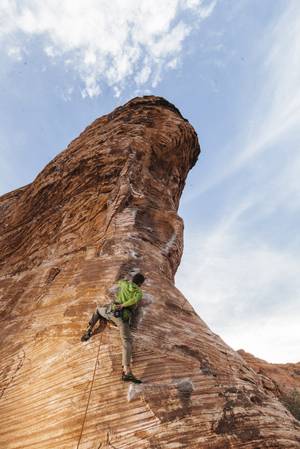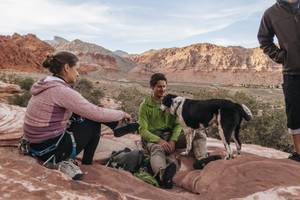Forty feet up, Xavier Wasiak takes a hand off the rock to shake out his fingers. His body hangs loose, comfortable there like some sticky-footed beetle going nowhere in particular. A few moves and he’s at the anchor of Caustic, a classic sport climb at Cannibal Crag just outside Red Rock Canyon. He knows the route. He’s been in a serious relationship with this sandstone microcosm for 20 years, but it still stuns him.
“There’s always a turn in a canyon, a wall that you hadn’t seen before. And it’s amazing and it’s lush and it’s verdant and it’s incredible. It’s so many different things—not just the desert and not even just the red rocks. It’s a super-cool place to be, a super-cool place to explore. And it’s home, you know? And challenging, and mean sometimes,” he says with a chuckle, flashing a palm scarred long ago on the climb he just dispatched.
Climbing is about battling and reveling, often in the same breath. And the collection of striated boulders, knifing cracks, big walls and arresting faces known as “Red Rocks” is one of its meccas, an international playground in consuming wilderness just off the Las Vegas Beltway. Protecting it is a colossal job involving conflicts of both passion and policy, and the Southern Nevada Climbers Coalition has been gamely at it for going on two decades. As a mountaineer buddy once told Wasiak: “The harder the journey, the cleaner the spirit.”
President of the volunteer advocacy group for the past three years, Wasiak was there when the SNCC was founded as the Las Vegas Climbers Liaison Council. He recalls veteran climber and original president Mark Limage organizing the group in 1998 to address the federal government's bolting ban under Wilderness Act regulations. A story in the Las Vegas Sun the following September detailed the memorandum of understanding the LVCLC entered into with the U.S. Forest Service and Bureau of Land Management to "promote the protection, management and enjoyment of climbing areas."
That dynamic holds, though the LVCLC was rebranded the SNCC this year, mostly to reflect the full scope of the climbing landscape in Southern Nevada, from the sandstone of Red Rocks to the limestone of Mount Charleston and Arrow Canyon to the granite of Keyhole Canyon and Christmas Tree Pass. The group's primary mission in all areas is stewardship, working with local climbers and land managers and national nonprofits like the Access Fund and American Safe Climbing Association to balance the sport's impacts and rewards. Because those who use the outdoors tend to be its fiercest angels.
"People can’t really care about or protect or understand natural resources unless they can recreate in them. I know that’s how I came to care about these spaces," Leici Hendrix says, echoing advocacy juggernaut the Access Fund, where she served as development director at its Colorado headquarters for seven years.
But Red Rocks is where she learned to rappel, where she led her first climb outdoors and got the hang of sport and traditional techniques after nailing the basics in a gym. Now SNCC's sponsorship lead, she still does consulting work for the Access Fund, which has been fighting for climbers and conservation of their sacred spaces since 1991. According to its website, one in five climbing areas in the U.S. is “threatened by an access issue.” They range from development claiming private land and over-regulation stifling use of public land to environmental degradation.
“Education is an issue that heavily affects access, just with the growth and explosion of climbing these days. There’s so many new climbers that there are not enough mentors to teach people how to behave outdoors,” Hendrix says. "They’ve never learned that it’s not okay to just poop anywhere you want to, and they’ve never learned that it’s not okay to just walk off-trail the whole way there and step on plants, and they don’t know that they shouldn’t encroach on other people’s space and blast music and yell loudly with their friends." Human waste is one of the most glaring concerns, as sensitive desert soil lacks the microorganisms to biodegrade it, and the contamination can have ripple effects. New climbers fresh from the gym aren't the only ones who need to hear this. Visiting climbers sometimes do, too, and they're coming in greater and greater numbers.
"We’re either going to make what beneficial impact we can on what’s happening today—which is that the sport is exploding and there’s a ton of people out here—or we can bury our heads in the sand and wish it was 20 years ago and wasn’t America great. But we can’t do that. That’s not the reality," Wasiak says. "So we can do the work to educate them and help them understand what’s important to us. I feel like that’s the fight to get into."
For the SNCC, the fight involves messaging through web forums like Mountain Project, mega-gatherings like the annual Red Rock Rendezvous and fundraising events like the recent Reel Rock Film Tour party at the Refuge climbing gym. It involves board members installing and maintaining waste-bag stations with support from the BLM, and giving clinics for those land managers and park employees on rock craft and the sport’s history here going back to the ’50s. Wasiak says the partnership with the BLM has been great. They meet once a month and discuss everything from development of a comprehensive signage program for Red Rocks to the ongoing issue of bolting. Hendrix says illegal installations are a huge problem. Even if restrictions were lifted, climbers have different views on what constitutes "necessity" of the metal hardware drilled into solid rock for protection against falls and anchors for rappelling. But there seems to be consensus on replacing sketchy bolts, whether they're rusted out, cracked with age or made of cheap materials.
Wasiak calls it “ominous and ginormous work,” and the climbing community is tackling it route by route thanks to individual volunteers and an SNCC team supplied with hardware by the American Safe Climbing Association. Matt Carpenter is part of that team, because he's driven to protect the area and the sport that enables “being in the views, seeing the exposure, looking down and realizing that where you’re at, maybe only 100 people have ever been in that moment, in that position looking down a 1,000-foot sheer cliff. ... Most people won’t agree, but there’s climbing in Red Rock Canyon all year-round. It’s 110 degrees down in the Valley, and you get back into Pine Creek Canyon and there’s water coming down, there’s frogs, there’s dragonflies. It’s a whole other world.”
Standing below Caustic, belaying SNCC communications lead McKenzi Taylor while their dog Bones keeps unblinking watch, Carpenter says joining was natural because they climb here so much and care deeply about what happens to this place.
"I wanted to know what was going on and have a say. Honestly, before I joined I didn’t even really know what the organization did. But being a part of it now, I realize the impact primarily of people in the canyon," Taylor says when she's back on the ground. Watching the handful of bodies moving up the boulder against the dusk, she points out that we're the only locals out here right now. While repping for the SNCC at the Red Rock Rendezvous last year, she really got how many people who climb here don't live here—and don't see the value in supporting a local advocacy organization. "But when you explain, 'Well, you're here now.' That was very eye-opening for them, and also for me."
That kind of connection is one of the goals of the Access Fund's Rock Project Tour, which kicks off in Las Vegas this May and involves local partners like REI, the Refuge, Origin Climbing & Fitness and the SNCC. Wasiak says the emphasis is on educating climbers who were born in the gym and want to go outside, and they'll be hit with a mix of parties and presentations, a service project at Red Rocks and plenty of clinics with pro athletes on the level of premier British trad climber Hazel Findlay and world-class boulderers Chris Schulte and Alex Johnson (who's on the SNCC board). Beyond the public event, there'll be a roundtable of strong voices in the greater climbing community letting it rip about current challenges and sharing insights about how to take them on. Wasiak thinks these chances for everyone to come together and download are crucial because climbing is so personal, from the style you favor to the movement’s expression of who you are. But at the heart of it, everyone just loves being out there, touching something rare.
"Being in the moment and being present and capable of controlling and making every decision without any sort of interruption—I think you can get into this flow headspace when you’re climbing that is unlike anything else, and that is a really powerful thing," Hendrix says. "I feel like I have a deep appreciation for the world around me, and because this is in my backyard and I get to go experience it and have a deep and close and intimate knowledge of it, it helps me relate to other people and how much they care about their backyard."
Rock Project Tour May 7-8, times and locations vary, $50, accessfund.org.







